|
Printables |
PowerPoints |
Online exercises |
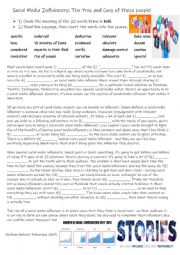
|
The phenomenal rise of ´┐ŻSocial Media Influencers´┐Ż: The Pros and Cons of these people!
500-Word reading article with a 20-word gap fill exercise about ´┐ŻInfluencers´┐Ż. It takes an in-depth look at their positive and negative influence in changing people´┐Żs minds and opinions on today´┐Żs topics of interest. An answer sheet is included. For higher level students they could be put in groups to give / present their opinions in a presentation...
Level: elementary
Age: 12-100
Type: worksheet
Downloads: 2217
|
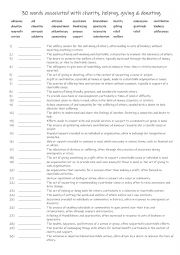
|
B1+-C1 30 words associated with charity, helping, giving & donating
Learning words associated with charity, helping, giving, and donating is crucial for enhancing understanding of social issues and the various ways to contribute to positive change. These terms improve communication about charitable activities, raise awareness of nonprofit work, and inspire individuals to get involved through volunteering or advocac...
Level: intermediate
Age: 8-100
Type:
Downloads: 112
|
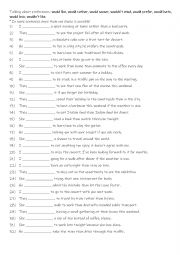
|
B1+-C1 Talking about preferences -would like, would rather, would sooner, would not mind, would prefer, would hate, would love & would not like.
Students familiarise themselves with the different ways of expressing their preferences and grammatical usage. Then they read each sentence to see which one is the most suitable to complete the gap-fill. Each form is used 4 times. Answers on page 2.
Level: intermediate
Age: 10-100
Type: worksheet
Downloads: 117
|
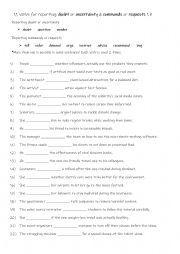
|
11 verbs for reporting doubt or uncertainty & commands or requests 1b
First, students need to familiarise themselves with the 11 verbs and check their meaning and use. Then they read the sentences to see which verb is needed to complete the sentence. Each verb is used 2 times! Answers on page 2
Level: elementary
Age: 9-100
Type:
Downloads: 108
|
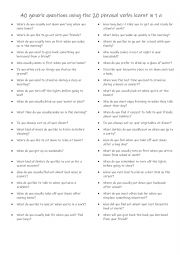
|
20 Phrasal verbs part 1 b worksheet
This is a speaking reinforcement activity for the phrasal verbs in Part 1 A. It contains 2 generic questions for each of the 20 phrasal verb. Suitable for pair work or small groups.This worksheet is suitable for CEFR A1 students.
Level: elementary
Age: 8-100
Type:
Downloads: 100
|
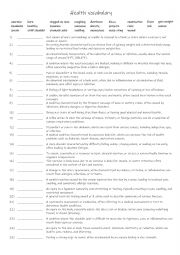
|
A2+-B1 25 Health vocabulary words
Students familiarise themselves with the 25 health related words and their meanings. Then they read the definitions and write the word being described in the space provided. Answers on page 2.
Level: elementary
Age: 8-100
Type:
Downloads: 120
|

|
A2-B1 Identifying 4 types of sentences 1
Learning to identify the four types of sentences enhances communication, writing, and grammar skills, helping students express ideas clearly and effectively. It also improves reading comprehension by allowing them to interpret tone and intent in texts. A strong understanding of sentence structures leads to better academic performance, particularly ...
Level: elementary
Age: 9-100
Type:
Downloads: 107
|
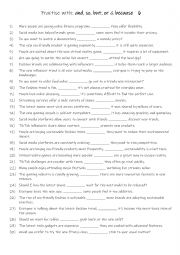
|
A1+- A2 Practise with and, so, but, or & because 6
First, students need to familiarise themselves with the 5 linkers and their usage. Then they read the sentences to see which one is needed to complete the gap-fill. Each conjunction is used 6 times! Answers on page 2.
Level: elementary
Age: 8-100
Type:
Downloads: 131
|
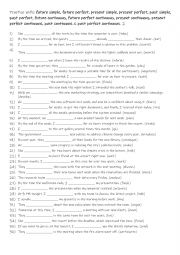
|
B1+-C1 12 Practise with: future simple, future perfect, present simple, present perfect, past simple, past perfect, future continuous, future perfect continuous, present continuous, present perfect continuous, past continuous & past perfect continuous. 2
Students should practise these tenses because they are essential for expressing actions and events in different time frames, allowing for clear and precise communication. By mastering these tenses, students can talk about future plans (future simple), describe ongoing actions (present continuous, future continuous), and show the connection between ...
Level: elementary
Age: 10-100
Type:
Downloads: 144
|
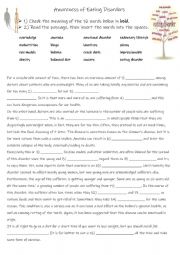
|
Awareness of Eating Disorders
Reading passage with a gap fill exercise about being aware and recognising signs of eating disorders. This sheet is suitable for higher level B1 to B2 students of all ages. An answer sheet is included. For higher level students they could be put in groups to give / present their opinions in a presentation / discussion.
Level: intermediate
Age: 14-100
Type:
Downloads: 1956
|
|
|
|
|












